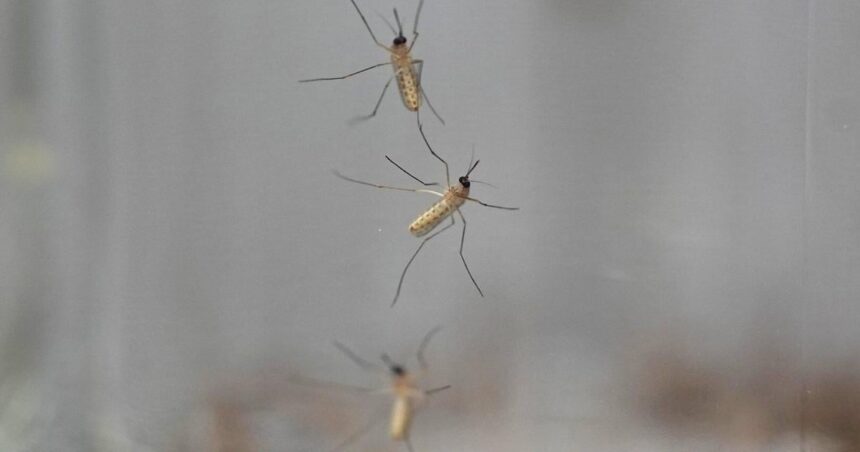I pull up my collar against the morning chill as I follow Dr. Emily Chen along a narrow trail beside Cheakamus Lake. The water gleams silver in the early light, rimmed by the silhouettes of western redcedars. Chen, an entomologist with the BC Centre for Disease Control, stops and points to a small cylindrical device hanging from a tree branch.
“This is one of our new surveillance traps,” she explains, adjusting her glasses. “We’ve placed twenty of these throughout the Sea-to-Sky corridor this summer.”
The unassuming device is part of British Columbia’s expanded mosquito monitoring program, launched this May in response to growing concerns about mosquito-borne diseases moving northward as our climate warms. The Sea-to-Sky region—stretching from Horseshoe Bay through Squamish and Whistler to Pemberton—is now dotted with these traps, silent sentinels in the fight against emerging health threats.
“We’re particularly concerned about West Nile virus and Western equine encephalitis,” Chen tells me as she carefully extracts the collection container. Inside, dozens of mosquitoes float in a preservation solution. “These will go back to our lab for species identification and testing.”
The program represents a significant shift in the province’s approach to mosquito-borne illness. While BC has historically had lower rates of such diseases compared to eastern provinces, climate change is altering that equation. According to data from Environment and Climate Change Canada, average temperatures in southwestern BC have increased approximately 1.3°C since the 1950s, creating more hospitable conditions for mosquito species previously unable to thrive here.
Jason Thompson, environmental health officer with Vancouver Coastal Health, explains why the Sea-to-Sky corridor was prioritized for surveillance. “This region combines ideal mosquito habitat—wetlands, lakes, and rivers—with high human activity. With millions of visitors each year, plus a growing permanent population, we need to understand what’s happening with our mosquito populations.”
As I watch Chen record data on her tablet, a group of hikers passes by on the trail. One notices the trap and asks what we’re doing. After Chen explains, a woman in the group mentions how mosquitoes seem worse than when she was a child visiting her grandparents’ cabin near Squamish. This casual observation aligns with what scientists are documenting more formally.
The BC Centre for Disease Control reported that 2023 saw a 22% increase in mosquito abundance across monitored sites in the province compared to the five-year average. More concerning, they identified two mosquito species new to the region that are known vectors for West Nile virus.
“People often think of mosquitoes as just a nuisance, but they’re actually the deadliest animal on earth when you consider the diseases they transmit globally,” says Dr. Bonnie Henry, Provincial Health Officer. While BC hasn’t yet seen locally acquired cases of West Nile virus, Henry emphasizes that “surveillance is our early warning system.”
Back at the BCCDC laboratory in Vancouver, I observe technicians sorting the day’s mosquito collections. Under powerful microscopes, they separate specimens by species, looking particularly for Culex tarsalis and Culex pipiens, primary vectors for West Nile virus in North America.
Dr. Muhammad Rahman, a medical entomologist who helped design the surveillance program, shows me a map of the trap locations. “We’ve strategically placed these in various microhabitats—near standing water, in forested areas, and close to human settlements,” he explains. “This gives us a comprehensive picture of mosquito activity throughout the region.”
The program doesn’t just count mosquitoes—it also analyzes them for the presence of viruses. Each week, pooled samples from the traps are tested using polymerase chain reaction (PCR) techniques similar to those used during the COVID-19 pandemic.
This surveillance extends beyond public health concerns. Jackie Zlotnik, an ecologist with the Squamish River Watershed Society, tells me that mosquito populations can also serve as indicators of ecosystem health. “Changes in mosquito species composition can signal shifts in wetland conditions or broader biodiversity issues,” she explains as we meet at the society’s offices.
Zlotnik’s organization has partnered with the surveillance program, contributing local ecological knowledge and helping to interpret findings within the context of watershed health. “Indigenous knowledge is particularly valuable here,” she adds. “Local First Nations have generational observations about insects and their relationships to seasonal changes.”
Indeed, the Squamish Nation has been consulted on the program’s implementation. Elder Latash Nahanee shares that their traditional calendar includes observations about mosquito emergence that date back centuries. “Our ancestors understood these patterns and had natural repellents made from local plants,” he tells me when I visit the Totem Hall community center.
For residents and visitors to the Sea-to-Sky region, the surveillance program remains largely invisible—few will notice the traps nestled in trees and shrubs. But the data being collected could prove crucial for public health planning.
Vancouver Coastal Health has developed response protocols based on surveillance findings. These range from public education campaigns to targeted larval control in high-risk areas if virus-positive mosquitoes are detected.
Dr. Chen reminds me that individual prevention remains important. “Use repellent containing DEET or icaridin when outdoors during peak mosquito activity, wear long sleeves and pants in the evening, and eliminate standing water around your property,” she advises as we finish our field work.
As the Sea-to-Sky region continues to grow in population and tourism, this enhanced vigilance against mosquito-borne diseases represents a proactive approach to community health protection. With climate change creating new vulnerabilities, the quiet work of these surveillance traps and the scientists who monitor them forms an essential front line in our adapting public health system.
The morning fog begins to lift from Cheakamus Lake as we pack up. Soon, the data collected here will join the growing body of knowledge about our changing environment and the challenges it presents. In this small way, British Columbia is preparing for a future where preventing disease requires understanding not just human behavior, but the complex ecological systems that surround us.






